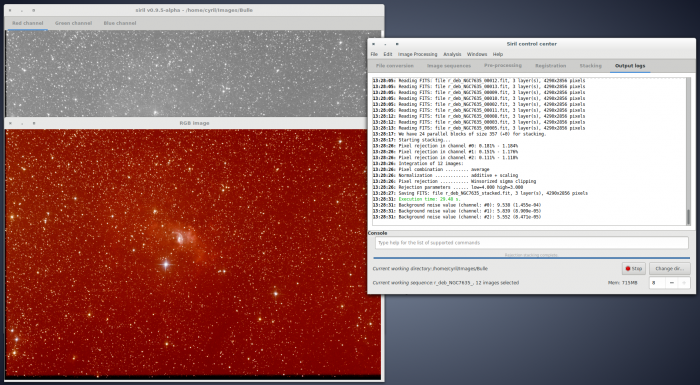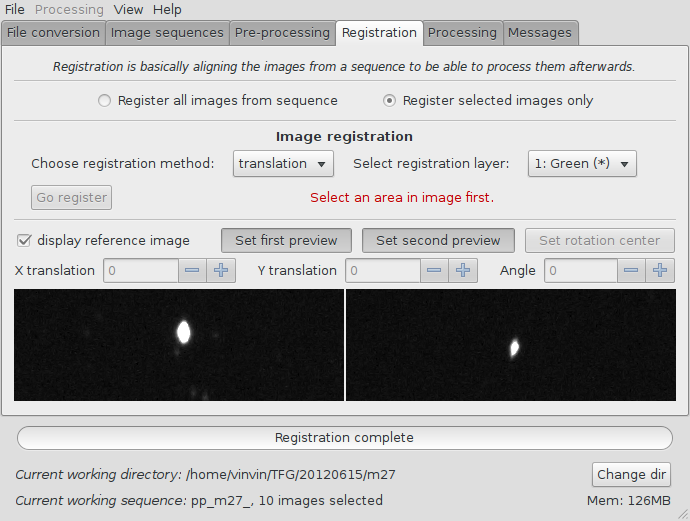Siril
Other languages: voir la page en français.
Siril was meant to be Iris for Linux (sirI-L). It is an astronomical image processing tool, able to pre-process images, help aligning them automatically or manually, stack them and enhance final images. The manual alignment capability makes it well fitted for amateur astronomers having a low volume of images and bad quality images that automatic tools fail to align properly. This page is the page for the new version of Siril, legacy Sourceforge project and website are unmaintained.
The software has been updated to recent operating system libraries (mainly to GTK+3) and still under development and quite unstable. Many improvements have been done over the previous unmaintained version, including better handling of conversions, image sequences and errors, improving the GUI, and lots of bug fixes. As of October 2013, the command line is being reactivated; the idea is to continue updating the commands so that they work with the new internal structures, and then add them in the GUI. Here is the list of commands currently available.
Siril's works internally with FITS images, unsigned 16-bit for each pixel information. All images you want to process with Siril thus need to be converted, except for SER sequences which are converted on-the-fly, see the stacking tutorial page.
Features
New features are being introduced quite regularly. Usual software features are explained with screen captures on the stacking tutorial page, and main features are:
- Native image format support
- unsigned 16-bit FITS files
- SER files
- AVI files soon
- Image conversion (to the native FITS format only)
- Supported input types: 8-bit BMP, short movie files (like .AVI), NetPBM binary images, RAW DSLR images.
- Image registration; supported methods:
- Translation for one selected star alignment using FFT.
This is not working fine at all.It appears that it works fine with good quality images (with nearly-round stars, not as bad as in the image above). - Manual translation with two preview renderings of the current image with reference frame in transparency.
- Image rotation is not implemented yet, but is under consideration.
- Using Theli is considered too, to align frames with a map (fixes image distortion, rotation, translation, according to many stars referenced by astrometry data).
- Translation for one selected star alignment using FFT.
- Image stacking
- Summing and median stacking.
- Pre-processing of images with multi-channel offset, dark and flat images.
- Enhancement of final images: lightness/contrast cursors on each layer, logarithmic and hyperbolic arcsin scale, negative rendering and others.
- The command line is being updated, see the list of available commands here.
Status of the new version (TODO and BUGS)
The more accurate information is available in the SVN log and in a file available on the SVN, TODO. It has a precise list of things to do and known bugs. Priority for next releases are re-enabling the automatic translation registration, adding support for wavelets and LRGB.
Dec 2, 2012: Version 61 begins the support for SER files (a frame sequence container) native use.
Oct 8, 2012: Version 54 is the first version actually able to stack (manually-)aligned images.
- Only color images and movies have been tested for now. Movies with numerous frames will require several GB of storage for now, since each frame is written to disk with a 16-bit pixel depth
- Only 3-channel colour images assigned to R, G and B are possible. Other assignations are to come, for LRGB or narrowband composition
- FWHM function does not work properly (badly implemented, soon fixed using astrofocuser's code)
- Automatic translation registration is not working well, but manual alignment can be done in a convenient way
- Warning: RAW images appear darker than in rawstudio or other RAW images visualisation tool because no automatic color and gamma correction are used
- Siril has light and contrast levels control with the common hi and lo cursors, but no gamma correction
- Median stack is limited to 50 frames to limit out of memory likeliness
- 16-bit BMP import fails
Compilation and installation
Siril is currently only released as source from its subversion base. There is a package for the Arch Linux system, built from the source, in AUR. For other OS, you need Subversion (svn command) to retrieve it and autotools and gcc to compile it. Mandatory dependencies are gtk+-3.4, cfitsio and fftw. Optional are dcraw and mplayer for RAW and AVI conversion, and can be installed after Siril's install. To get the source, use the command:
svn co https://free-astro.vinvin.tf/svn/siril/
(sorry for the bad certificate - this URL does not work for online source viewing with old web browsers). The source is read-only if you have no particular authorization. If you want to participate to Siril and be able to commit on the svn, send a message to user Vincent here.
Once you have got Siril's source code, it's easy to install it. Siril is managed with autotools, so it's simply built using ./configure and make. However, the configure file is not given to allow for better interoperability and has to be generated using this command:
$ aclocal && autoconf && autoheader && automake --add-missing
Then run ./configure and make. To install Siril, use the usual:
$ make install
Default installation directory is probably /usr/local. To launch Siril, the command name is siril.

